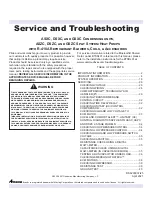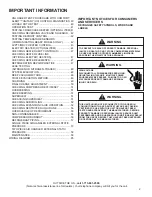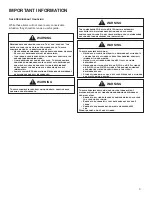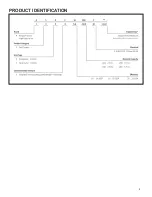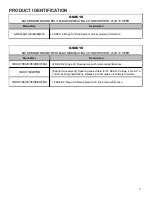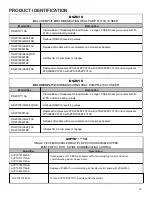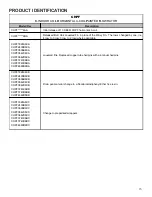
IMPORTANT INFORMATION
3
Safe Refrigerant Handling
While these items will not cover every conceivable
situation, they should serve as a useful guide.
WARNING
Refrigerants are heavier than air. They can “push out” the
oxygen in your lungs or in any enclosed space. To avoid
possible difficulty in breathing or death:
•
Never purge refrigerant into an enclosed room or space.
By law, all refrigerant must be reclaimed.
•
If an indoor leak is suspected, thoroughly ventilate the
area before beginning work.
•
Liquid refrigerant can be very cold. To avoid possible
frostbite or blindness, avoid contact with refrigerant
and wear gloves and goggles. If liquid refrigerant
does contact your skin or eyes, seek medical help
immediately.
•
Always follow EPA regulations. Never burn refrigerant,
as poisonous gas will be produced.
WARNING
To avoid possible injury, explosion or death, practice safe
handling of refrigerants.
WARNING
The compressor POE oil for R-410A units is extremely
susceptible to moisture absorption and could cause
compressor failure. Do not leave system open to atmosphere
any longer than necessary for installation.
WARNING
To avoid possible explosion:
•
Never apply flame or steam to a refrigerant cylinder. If
you must heat a cylinder for faster charging, partially
immerse it in warm water.
•
Never fill a cylinder more than 80% full of liquid
refrigerant.
•
Never add anything other than R-22 to an R-22 cylinder
or R-410A to an R-410A cylinder. The service equipment
used must be listed or certified for the type of
refrigerant used.
•
Store cylinders in a cool, dry place. Never use a cylinder
as a platform or a roller.
WARNING
To avoid possible explosion, use only returnable (not
disposable) service cylinders when removing refrigerant
from a system.
•
Ensure the cylinder is free of damage which could lead
to a leak or explosion.
•
Ensure the hydrostatic test date does not exceed 5
years.
•
Ensure the pressure rating meets or exceeds 400
lbs.
When in doubt, do not use cylinder.
Summary of Contents for ASXC16
Page 4: ...PRODUCT IDENTIFICATION 4 ...
Page 5: ...PRODUCT IDENTIFICATION 5 ...

